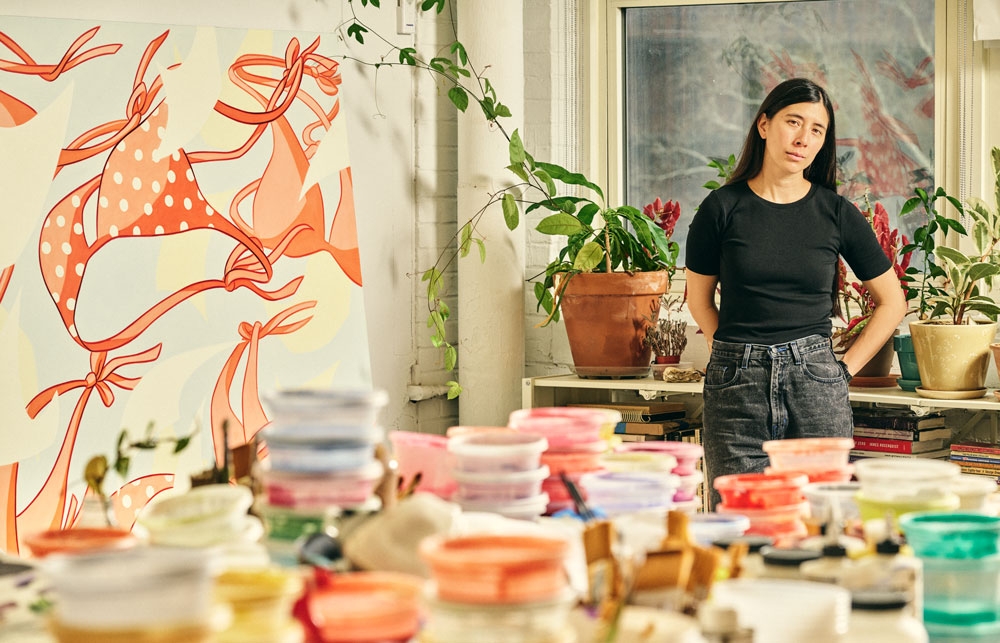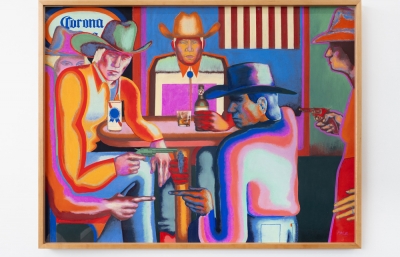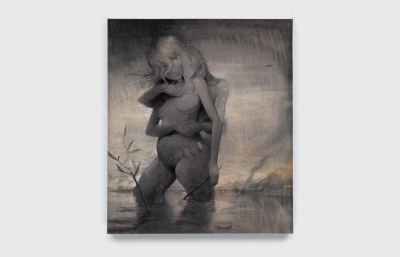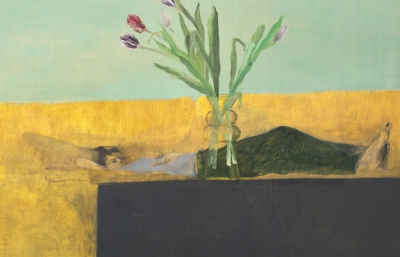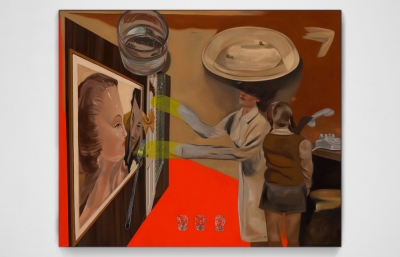Ivy Haldeman
Notions of Slippage
Interview by Evan Pricco // Portrait by Bryan Derballa
One of the things I love about Ivy Haldeman is the way she lets you know that the world isn't quite what it seems. Everything is recognizable as you try to figure out why something out of context feels uncomfortably heavy. Has something ominous happened to the person once wearing the floating bikinis? Closing in on the men in suits, should we assume they are brokering a deal for peace or readying for war? And in her last show at François Ghebaly in Los Angeles in early 2024, The Agreement, The Fool, and The Storm, the gallery referenced something that has stuck with me over the last few weeks: "Notions of ‘slippage’ are at the heart of Haldeman’s art, and the exhibition is a study in the push-pull between image and power."
Haldeman drew the attention of the art world in recent years for paintings of hot dog people, a bright collection of minimalistic and satirical works that gave identity to an otherwise pop-cultural icon that probably hadn’t seen the light of a white gallery in quite some time (or any time). But those hot dogs, along with her new series of bikinis, empty suits, and secret handshakes that can only be a depiction of a sinister business deal, give the viewer a depth to consider, or a reflection of the recognizably common being the surface of something rather complex and powerful. In The Agreement, The Fool, and The Storm, Haldeman paints the bits of swimwear under the guise of the Bikini Atoll in the South Pacific when, in 1946, the U.S. military began a series of tests with nearly two dozen hydrogen bombs on land, over the ocean, and in the coral reefs around the islands. About 8,000 miles away, French designer Louis Réard “co-opted the atoll’s name to describe what Ghebaly gallery notes is “another mid-century provocation of superlative proportions, one that would come to define gendered aesthetics for decades to come: ‘the Bikini—smaller than the smallest swimsuit in the world.’” And here we begin to see the scope of Haldeman’s bodies of work.

Indeed, things are not what they seem in these paintings, and yet they have a heaviness in the most abstract of ways: a place of war connects directly to a tiny bathing suit; a handshake in paradise portends an apocalypse. The sheer size of these works, almost mural sized, overwhelms with something seductively alluring, but beneath every utopia wends a direct line to dystopian results.
Evan Pricco: I'm so excited to speak with you and almost a little nervous because I just really love the work and have so many things I want to ask and discuss. First of all, one thing is that this past year at Art Basel Miami, I had an incredible video of one of your hot dog paintings and a man in a pinkish colored suit, matching the hot dog color, walking past. I saw it happening, and I just got the perfect timing and theater—a brilliant juxtaposition. The hot dog was, like, finger on chin, checking this dude's suit. It was perfect. So finally, how much do you think of these situations when you are about to showcase or bring these paintings out to the world, the gaze of a hot dog to us, and us to the idea of the hot dog?
Ivy Haldeman: Ha! That sounds like a very nice moment. Paintings certainly have a presence in a room, just as any person might. The hot dog paintings were always meant to feel calm and open. I use broad swaths of color, empty areas, and unobtrusive brush marks, and I think this leaves room for the viewer to incorporate themselves in the scene, as you’re suggesting, both physically and empathetically. It's meant to be inviting, to start a conversation.
On the other hand, while the formal aspects of the painting—color, texture, and space—let you in, the figure can be withholding. The body language, the gaze of the hot dog, is slightly turned from the viewer, mid-gesture and without intent. This isn’t meant to repulse the viewer, but rather to slow them to a halt. The painting is a place where time is still.
When did you paint the first hot dog? How did that feel leaving your studio?
In 2011, I drew a hot dog person using sumi ink on printer paper. It was a notation, a memory of an advertisement that I had seen on the street. It felt like such a ridiculous subject for a painting, so I tucked it away in a cabinet.
I made my first hot dog painting on canvas in 2016. I told myself I wasn’t going to make a painting until I had drawn the subject 100 times. It was a time of pure focus, like electricity in your mind and in your hands. I had this feeling of conversing with something larger than myself.

What's a misconception about your work that you feel like you are challenged with?
People often talk about the characters in my work. I think of my subjects less as characters and more as excuses for composition, forms to play with to find the potentials of line, color, and meaning. I aspire to something more abstract.
People often talk about the characters in my work. I think of my subjects less as characters and more as excuses for composition, forms to play with to find the potentials of line, color, and meaning. I aspire to something more abstract.
You are from Aurora, Colorado, and then went to Cooper Union in NYC. What were you hoping was going to happen when you finished school? What was 2008’s Ivy looking at in terms of the landscape of art?
When I finished art school, I signed up for an EMT course. There was a recession going on. For a while, I doubted that art was a viable life path, and I was trying to figure out how I could be helpful to society. But ultimately, I kept hanging out with artists, not just ones my age but older artists, ones who had started working at a time when figuration was largely looked down on, and I spent a lot of time reaching for conceptual things, stacking concrete blocks on rooftops, making websites with full screen videos, and painting canvases in dark, impenetrable colors.
I also recall some pretty lecherous characters—gallerists, art writers, artists—it was dodgy trying to be an artist as a young woman! (It still is.)
Did something about NYC trigger a better sense of critiquing and creating these really bold and minimal observations of human interactions and human identity?
I worked as a nanny in NYC for many years. I remember being on the subway with one girl I was babysitting, and we were having a moment of imaginative play. Our hands had become people, and they were walking and strutting along the subway poles. The contrast between these intimate moments and the hustle of the streets that I was helping these kids navigate, literally trying to keep them from getting run over, threw the tenderness of our interiorities into relief. I think I am always on the lookout for that kind of tenderness.

What did the hot dog, a most universally funny "character" that perhaps an American can think of, allow you to achieve as an artist?
Before I started making hot dog paintings, I was painting these black paintings, very much like Ad Reinhardt meets Gerhard Richter. There were very faint figures in the darkness, but you couldn’t see them unless you came right up to the canvas. I had a studio visitor at the time who glanced at these black rectangles when they walked through the door, and I think they assumed I was an asshole, that I had invited them over to look at empty canvases. They were afraid to say anything and were very relieved when I drew them closer.
The beauty of a hot dog is that it has the visual language of inclusion built into it. The image is inviting. It reminds people of places they’ve been, humorous observations they’ve had. It sets the stage for a warm interaction.
Is the work, dare I say, funny? I find it quite heavy, but I had a friend tell me there is such a humorous depth to this work, and I think I had to agree.
I think you and your friend are both right. For me, there is a thin line between what’s humorous and serious in the work. A breakthrough moment for me was not to think of the hot dog as a funny object but rather to empathize with it. When you start to do that, you realize you may not be so different from these ridiculous objects after all. That doesn’t mean you should set humor aside. Sometimes, when your friends are in pain, you feel it. You tell them jokes to keep them from crying.
I want to jump to the recent show at Ghebaly, The Agreement, The Fool, and The Storm. It was absolutely brilliant, both in content and historical context. Talk to me a bit about the concept of the show—this sort of darkness behind what appears to be nods to both paradise and capitalism.
I was very nervous when I decided to paint a bikini; it felt frivolous and commercial. The image kept bringing me back to the beach, automotive calendars, and associations of leisure and masculinity. But I also had this association with hurricanes. I lived briefly in Hawaii as a kid, and I experienced Iniki, a devastating hurricane that hit Oahu in 1992. Since then, I’ve always had this feeling that paradise is fragile or deceptive, to say nothing of the history of colonialism in such places.
Another image that I was trying to understand, something that felt lodged in my psyche, was the image of falling paper from 9/11. It’s such a contradictory image, so horrific, and yet, also so graceful. It’s the image of an office disaster; it’s the aesthetic paper caught in the wind in the famous Hokusai’s print. The paper reminds me of the force of the wind—the feeling that you could be engulfed or tossed away. It’s a reminder of the threat of a sudden storm, of climate change, and of a catastrophe that we are watching in real time.
I was also entranced by the etymology of “bikini.” Bikinis were named after the nuclear weapons tests at Bikini Atoll in 1946, after the Second World War. They are a schematic for a relationship between commercial boldness and military power. And I was attracted by the irony: the boldness came in the form of a deeply vulnerable piece of clothing, a world historical reference that I might wear on my personal body.
The exhibition really is a meditation on individual experience, riding the waves of historical events, watching business deals being made, military action being taken, and ultimately feeling that I am the powerless spectator, a sort of fool.

Those three paintings of the handshakes have this sinister feeling. Before I read the press release for the show, I went and stared at those handshake paintings and had this gut reaction of something so dark happening, even in the brightness of the work. How hard is it, do you think, for an artist to achieve that sort of balance of dark and light? To delight and scrutinize simultaneously?
It's hard. There is a lot of editing that happens in my studio: drawings that are too silly, drawings that are too self-serious. I use my own interest in the composition as a guide. I find that when you start to veer to either side, you get very tired and bored.
The banana is part of this show as well. Unlike the hot dog, it's not really a character, but this bright object is rather a vulnerable object as well. This seems to be a theme you frequently approach, vulnerability with power. Can you elaborate?
In many of my works, I take objects, often symbolic of capitalism and gender norms, and try to loosen them from their associations. I want to be able to relate to these symbols on my own terms and not be too swayed by their baggage.
For example, a business suit uses the geometry of straight lines to ward off any association of pliancy or softness. The arms are straight, like the hands of a clock ticking. I took the visual language of the suit and played with it, giving it curves and making it more flexible, hoping that I could get it to speak to something more expressive and thus more vulnerable—something that I know is there but hidden.
Even though some of your works are smaller, the bikini and suit works are quite large, the bikini one is almost mural-sized. How does scale work for you?
When I have the opportunity, I like to think of scale in a literal way. For this exhibition, it was important to have a 9 foot bikini. It needed to suggest an overwhelming presence, something that could completely encompass you and totally sweep your body away.
It's also an art history gag. To make a painting of a bikini, with its connotations of frivolity and feminine leisure, at the scale of a regal historical painting, like Napoleon on horseback, lets me play with that traditional hierarchy of subjects.

There was something you said recently that really stood out, that made me feel like I wanted to understand my role as a viewer: “There’s something about shaking images loose from our expectations. We can put emphasis on how we arrived at those expectations in the first place and on where we might still find some agency.” I'm curious, what artist had this impact?! When did you begin to see how other artists were shaking images loose from expectations for you?
After college, I had a chance to visit the Prado in Madrid and see Goya's portraits of royalty. Some of these paintings are very silly; the figures are small and unimpressive with pink, rosy faces. They are in clear contrast to the drama and vigor that Goya captures in his Los Caprichos prints, or his black paintings, which often give ordinary people the aura of mythology and folklore. I was expecting adulation in the royal portraits but was confronted by something that felt very muted and cynical, plain and earthly. I couldn't help but wonder if Goya did it on purpose.
I also often think about Marlene Dumas. Take her work, The Painter, drawn from a snapshot of a child. With these dripping red and blue hands, the figure looks like a murderer—but are they supposed to be an artist or a child?

What's the last piece of art that has moved you?
Akira Kurosawa’s Ikiru. There is a scene where a woman speaks so passionately about constructing wind-up rabbits! It’s her reason for living. She says, “When I help to make these in the factory, I feel as if I am playing with every baby in Japan.” It’s spectacular.
Follow Ivy Haldeman at @that_ivy // This interview was originally published in our SUMMER 2024 Quarterly // Ivy will present a work on paper in "I'd Love To See You," A Juxtapoz Story at 30, Pt 1, opening June 29th at Rusha and Co in Los Angeles. Curated by Evan Pricco and Kim Stephens.

